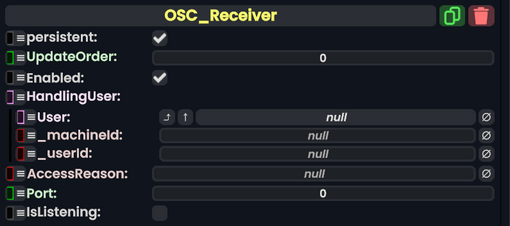Component image 
OSC Receiver component as seen in the Scene Inspector

The OSC_Reciever component creates an OSC Server within Resonite to receive OSC messages.
Fields
| Name | Type | Description |
|---|---|---|
persistent
|
Bool | Determines whether or not this item will be saved to the server. |
UpdateOrder
|
Int | Controls the order in which this component is updated. |
Enabled
|
Bool | Controls whether or not this component is enabled. Some components stop their functionality when this field is disabled, but some don't. |
HandlingUser
|
direct UserRef | The OSC Reciever creates the OSC server on this User's machine. |
AccessReason
|
String | Displayed in the Host Access Dialog when a connection is trying to be established. |
Port
|
Int | Network port to listen on for OSC connections |
IsListening
|
Bool | This value is set to true when Resonite is successful in opening a network connection to receive data on. |
Usage
Once Handling User and Port are set, To actually receive data, you should use the Value components:
Examples
- See OSC.
Limits
There are no limits to the number of OSC Paths that can be used to receive data.
When using a Headless Server the OSC address must be set to "localhost", using 127.0.0.1 will not work.